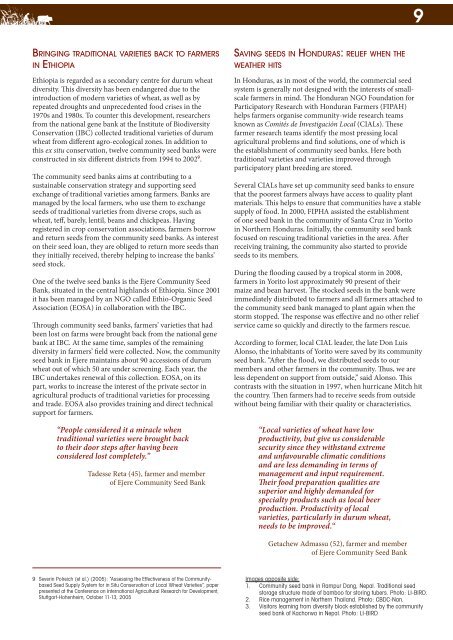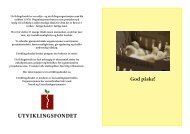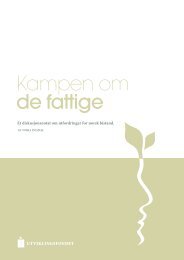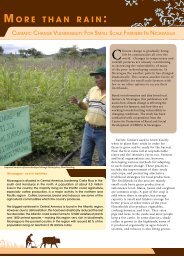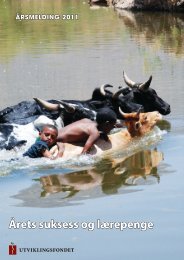Banking for the future: - Third World Network
Banking for the future: - Third World Network
Banking for the future: - Third World Network
- No tags were found...
Create successful ePaper yourself
Turn your PDF publications into a flip-book with our unique Google optimized e-Paper software.
9Bringing traditional varieties back to farmersin EthiopiaEthiopia is regarded as a secondary centre <strong>for</strong> durum wheatdiversity. This diversity has been endangered due to <strong>the</strong>introduction of modern varieties of wheat, as well as byrepeated droughts and unprecedented food crises in <strong>the</strong>1970s and 1980s. To counter this development, researchersfrom <strong>the</strong> national gene bank at <strong>the</strong> Institute of BiodiversityConservation (IBC) collected traditional varieties of durumwheat from different agro-ecological zones. In addition tothis ex situ conservation, twelve community seed banks wereconstructed in six different districts from 1994 to 2002 9 .The community seed banks aims at contributing to asustainable conservation strategy and supporting seedexchange of traditional varieties among farmers. Banks aremanaged by <strong>the</strong> local farmers, who use <strong>the</strong>m to exchangeseeds of traditional varieties from diverse crops, such aswheat, teff, barely, lentil, beans and chickpeas. Havingregistered in crop conservation associations, farmers borrowand return seeds from <strong>the</strong> community seed banks. As intereston <strong>the</strong>ir seed loan, <strong>the</strong>y are obliged to return more seeds than<strong>the</strong>y initially received, <strong>the</strong>reby helping to increase <strong>the</strong> banks’seed stock.One of <strong>the</strong> twelve seed banks is <strong>the</strong> Ejere Community SeedBank, situated in <strong>the</strong> central highlands of Ethiopia. Since 2001it has been managed by an NGO called Ethio-Organic SeedAssociation (EOSA) in collaboration with <strong>the</strong> IBC.Through community seed banks, farmers’ varieties that hadbeen lost on farms were brought back from <strong>the</strong> national genebank at IBC. At <strong>the</strong> same time, samples of <strong>the</strong> remainingdiversity in farmers’ field were collected. Now, <strong>the</strong> communityseed bank in Ejere maintains about 90 accessions of durumwheat out of which 50 are under screening. Each year, <strong>the</strong>IBC undertakes renewal of this collection. EOSA, on itspart, works to increase <strong>the</strong> interest of <strong>the</strong> private sector inagricultural products of traditional varieties <strong>for</strong> processingand trade. EOSA also provides training and direct technicalsupport <strong>for</strong> farmers.“People considered it a miracle whentraditional varieties were brought backto <strong>the</strong>ir door steps after having beenconsidered lost completely.”Tadesse Reta (45), farmer and memberof Ejere Community Seed BankSaving seeds in Honduras: relief when <strong>the</strong>wea<strong>the</strong>r hitsIn Honduras, as in most of <strong>the</strong> world, <strong>the</strong> commercial seedsystem is generally not designed with <strong>the</strong> interests of smallscalefarmers in mind. The Honduran NGO Foundation <strong>for</strong>Participatory Research with Honduran Farmers (FIPAH)helps farmers organise community-wide research teamsknown as Comités de Investigación Local (CIALs). Thesefarmer research teams identify <strong>the</strong> most pressing localagricultural problems and find solutions, one of which is<strong>the</strong> establishment of community seed banks. Here bothtraditional varieties and varieties improved throughparticipatory plant breeding are stored.Several CIALs have set up community seed banks to ensurethat <strong>the</strong> poorest farmers always have access to quality plantmaterials. This helps to ensure that communities have a stablesupply of food. In 2000, FIPHA assisted <strong>the</strong> establishmentof one seed bank in <strong>the</strong> community of Santa Cruz in Yoritoin Nor<strong>the</strong>rn Honduras. Initially, <strong>the</strong> community seed bankfocused on rescuing traditional varieties in <strong>the</strong> area. Afterreceiving training, <strong>the</strong> community also started to provideseeds to its members.During <strong>the</strong> flooding caused by a tropical storm in 2008,farmers in Yorito lost approximately 90 present of <strong>the</strong>irmaize and bean harvest. The stocked seeds in <strong>the</strong> bank wereimmediately distributed to farmers and all farmers attached to<strong>the</strong> community seed bank managed to plant again when <strong>the</strong>storm stopped. The response was effective and no o<strong>the</strong>r reliefservice came so quickly and directly to <strong>the</strong> farmers rescue.According to <strong>for</strong>mer, local CIAL leader, <strong>the</strong> late Don LuisAlonso, <strong>the</strong> inhabitants of Yorito were saved by its communityseed bank. “After <strong>the</strong> flood, we distributed seeds to ourmembers and o<strong>the</strong>r farmers in <strong>the</strong> community. Thus, we areless dependent on support from outside,” said Alonso. Thiscontrasts with <strong>the</strong> situation in 1997, when hurricane Mitch hit<strong>the</strong> country. Then farmers had to receive seeds from outsidewithout being familiar with <strong>the</strong>ir quality or characteristics.“Local varieties of wheat have lowproductivity, but give us considerablesecurity since <strong>the</strong>y withstand extremeand unfavourable climatic conditionsand are less demanding in terms ofmanagement and input requirement.Their food preparation qualities aresuperior and highly demanded <strong>for</strong>specialty products such as local beerproduction. Productivity of localvarieties, particularly in durum wheat,needs to be improved.“Getachew Admassu (52), farmer and memberof Ejere Community Seed Bank9 Severin Polreich (et al.) (2005): ”Assessing <strong>the</strong> Effectiveness of <strong>the</strong> CommunitybasedSeed Supply System <strong>for</strong> in Situ Conservation of Local Wheat Varieties”, paperpresented at <strong>the</strong> Conference on International Agricultural Research <strong>for</strong> Development,Stuttgart-Hohenheim, October 11-13, 2005Images opposite side:1. Community seed bank in Rampur Dang, Nepal. Traditional seedstorage structure made of bamboo <strong>for</strong> storing tubers. Photo: LI-BIRD.2. Rice management in Nor<strong>the</strong>rn Thailand. Photo: CBDC-Nan.3. Visitors learning from diversity block established by <strong>the</strong> communityseed bank of Kachorwa in Nepal. Photo: LI-BIRD


